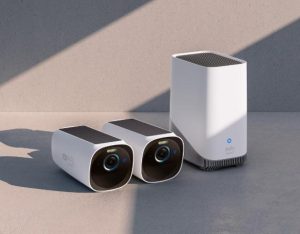A reliable outdoor camera plays a crucial role in safeguarding your property and ensuring round-the-clock peace of mind. Selecting the right model means evaluating its durability, visual clarity, connectivity, and smart features. This guide breaks down the most important elements to consider, helping you make an informed decision. By focusing on performance, security, and ease of use, you can ensure your outdoor camera remains effective under various conditions for years to come.
Key Features of a Reliable Outdoor Camera
Weather Resistance and Durability
Outdoor cameras must endure rain, heat, cold, and wind year-round. Always check for an IP rating—IP66 or higher ensures protection against dust and strong water jets. The housing should be built from durable materials like reinforced plastic or metal. Such construction prevents wear and tear and keeps internal components safe. Weatherproof design guarantees the camera continues to operate efficiently, even during harsh weather or unexpected environmental changes.
Night Vision and Low-Light Performance
Reliable night surveillance depends on how well a camera performs after sunset. Infrared LEDs help capture clear black-and-white footage in total darkness, while some models provide color night vision for added detail. Good low-light performance ensures intruders can be identified, not just detected. Look for cameras with wide dynamic range (WDR) or low-light sensors to maintain consistent image quality in dim conditions, from dusk until dawn.
Motion Detection Technology
Accurate motion detection minimizes false alerts and conserves storage. Cameras with customizable motion zones allow you to focus on critical areas while ignoring background movement. More advanced models use AI-based object recognition to differentiate between people, pets, and vehicles. This reduces unnecessary notifications and ensures you’re only alerted when real activity is present, giving you better control and confidence in your system’s responsiveness.
Why Video Quality Matters in Outdoor Cameras
HD vs. 4K Video Resolution
Video resolution directly impacts your ability to recognize faces or license plates. HD (1080p) provides adequate clarity for general monitoring, but 4K offers superior sharpness and zoom detail. The added clarity is particularly useful in large areas or where you need close inspection. Consider whether you need higher resolution and if your storage solution supports the larger file sizes that come with 4K recording.
Frame Rate and Image Clarity
A higher frame rate results in smoother video playback and sharper motion tracking. Cameras that record at 30 fps or higher are ideal for identifying fast-moving objects without blur. In contrast, lower frame rates may skip important moments or cause distortion. For active environments like driveways or sidewalks, prioritize cameras with high frame rates to ensure you’re not missing essential movement or compromising security.
Audio and Two-Way Communication
Built-in microphones enhance situational awareness by capturing ambient sounds, like voices or footsteps. Two-way audio systems go further by enabling direct conversation through the camera—ideal for welcoming guests or warning trespassers. Look for features such as noise reduction and echo cancellation to improve clarity. Integrating audio capabilities into your setup adds a valuable communication layer and increases your security’s adaptability in real-time scenarios.
The Role of Connectivity in Outdoor Camera Performance
Wi-Fi and Bluetooth Range
Stable connectivity is vital for continuous surveillance. Cameras with strong Wi-Fi modules can maintain a solid connection even when placed far from the router. Bluetooth is useful during initial setup or pairing with mobile apps. If your camera loses connection often, it can miss crucial events. Consider using Wi-Fi extenders or mesh systems to expand your coverage and ensure consistent operation across your entire property.
Cloud vs. Local Storage Options
Cloud storage allows footage to be reviewed and managed remotely, offering convenience but often requiring subscription fees. Local storage via SD card or network-attached storage (NAS) ensures control without recurring costs. However, local storage can be damaged or stolen. Choose based on your preferences for accessibility, cost, and data security. Some users even opt for hybrid solutions to enjoy the benefits of both storage types.
Integration with Smart Home Devices
A camera that integrates with your smart home ecosystem streamlines monitoring and management. Compatibility with Alexa or Google Assistant allows voice commands and automation routines. For example, cameras can trigger lights or alarms when motion is detected. Smart integration not only increases usability but also helps you create a connected security environment that adapts to your lifestyle and provides a unified user experience.
How to Maintain Your Outdoor Camera for Longevity
Regular Cleaning and Lens Maintenance
Outdoor environments can quickly dirty camera lenses with dust, bugs, and moisture. Clean lenses mean clearer footage and more reliable identification. Use microfiber cloths and lens-safe cleaners to avoid scratches. Check for condensation inside the lens housing, which may indicate seal failure. Cleaning should be part of your monthly maintenance routine to prevent visual obstruction and keep your camera recording high-quality footage.
Firmware Updates and System Security
Firmware updates are essential for keeping your device secure and performing optimally. Manufacturers often release patches that address security flaws, bugs, and feature improvements. Neglecting updates can leave your camera vulnerable to cyber threats. Enable automatic updates if available, or manually check the manufacturer’s website. A well-maintained software environment ensures your camera adapts to evolving threats and remains compatible with new features and systems.
Proper Placement for Optimal Coverage
Correct placement can greatly enhance your camera’s coverage and effectiveness. Install the camera high enough to prevent tampering but angled correctly to cover key access points like doors, gates, and driveways. Avoid direct sunlight, which may cause glare, and ensure adequate nighttime lighting. Using multiple cameras with overlapping fields of view reduces blind spots. Good positioning ensures the camera captures activity where it matters most.
Conclusion
Selecting a reliable outdoor camera means evaluating multiple components—from build quality and resolution to smart features and maintenance requirements. A well-chosen camera not only captures clear footage but also integrates smoothly with your home systems and holds up over time. Regular upkeep ensures it continues functioning as expected. With the right balance of features and placement, your system will deliver consistent performance and help you stay secure in any outdoor environment.

Oliver Smith is an experienced blogger at Grammar Globe, Oliver Smith, an expert in English grammar and a master of wit, brings language to life with his playful take on puns. Through his works, he weaves humor into the rules of grammar, making learning fun and engaging for readers of all ages. Discover language with a smile!”







